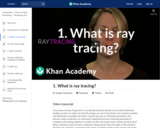
Introduction to the basics of ray tracing.
- Subject:
- Applied Science
- Arts and Humanities
- Computer Science
- Graphic Arts
- Material Type:
- Lesson
- Provider:
- Khan Academy
- Provider Set:
- Pixar
- Author:
- Disney Pixar
- Khan Academy
- Date Added:
- 07/14/2021

Introduction to the basics of ray tracing.

In this Wonder of the DayR, we learn about why flamingos are pink. Students have the opportunity to explore the Wonder either as a class or individually. With suggestions for different age groups, Wonder #1 has an activity to engage students with drawing, writing description, or both.

, We will learn about why flamingos are pink. Students have the opportunity to explore as a class or individually. With suggestions for different age groups. This resource has some activities to engage students with drawing, writing descriptions, or both.

In this Wonder of the DayR, we learn about why flamingos are pink. Students have the opportunity to explore the Wonder either as a class or individually. With suggestions for different age groups, Wonder #1 has an activity to engage students with drawing, writing description, or both.

This set of resources was developed and employed numerous times to help students clarify the frequent confusion about cells' chromosome number and ploidy level. It uses simplified stick diagrams to represent chromosomes and circles or oval to represent cells and includes a short, low-tech video tutorial that delivers the information, a worksheet that students can use to practice and test their understanding of the video materials, a set of clicker questions that address the same points as the worksheet, and instructor's notes.

In this lesson children will be asked to make a graph, then listen to a story. After the story, they will do a similar graph and then compare the two graphs.
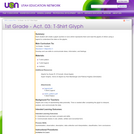
In this lesson each student will create a glyph (symbol or icon) which represents them and read the glyphs of others using a legend to understand the data on the glyphs.
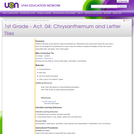
In this lesson children will listen as the teacher reads Chrysanthemum. Afterwards have a discussion about the story with a focus on the length of ChrysanthemumŐs name. Have the children compare the lengths of their own names using letter tiles, grid paper, and a class graph.

In this lesson students will listen and match sounds ... either rhyming sounds, beginning sounds, ending sounds or vowel sounds.

This lesson will help students understand how to identify, create, and label simple patterns.
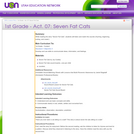
While reading the story "Seven Fat Cats", students will listen and match the sounds (rhyming, beginning, ending, and vowel.)
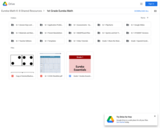
concepts found in Eureka Math- 1st grade

This lesson was created to teach students what the main elements of a fable are.

Mathematics:After completing this module, the student will able to: 1. Repeat the steps to solve for an equation2. Compute the numbers together3. Solve equations4. Breakdown the problems5. Create similar problems to solve6. Compare the problems to each other

Mathematics:After completing this module, the student will able to: 1. Repeat the steps to solve for an equation2. Compute the numbers together3. Solve equations4. Breakdown the problems5. Create similar problems to solve6. Compare the problems to each other

Overview: In this lesson, students will particpate in three separate learning activities. These activities are each made to help improve the students' knowledge of creating real-world problems to represent an addition and a subraction equation within 20. At the end of the lesson, there is an assessment in order to check the effectivenss of the learning activities
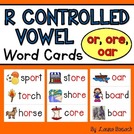
This Lesson Plan was created by Molly Simpson. The attached Lesson Plan is designed for Grade 1 English Language Arts students. Students will be able to understand and spell the words using their knowledge of the various spellings of the same sound: "oar, "or", and "ore". This Lesson Plan can be used with small group instruction or with a whole class. This lesson plan adresses the following NDE Standards: . It is expected that this Lesson Plan will take students 20 to 80 minutes to complete depending on the use of small group or large group instruction.

Teaching students how to retell a story to their peers or teachers.

1st grade science key vocabulary English/Spanish translations (space to add drawing as well).

This lesson will help students understand how a shadow is created and allow them to experiment with creating shadows.